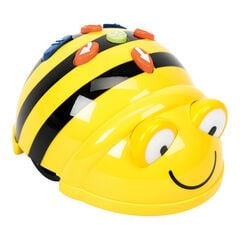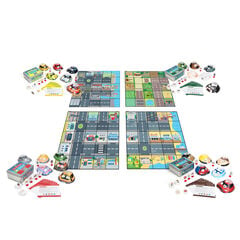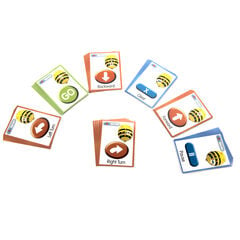International Day of the Programmer is celebrated on “the 256th (hexadecimal 100th, or the 28th) day of each year (September 13 during common years and on September 12 in leap years). The number 256 (28) was chosen because it is the number of distinct values that can be represented with an eight-bit byte, a value well-known to programmers. 256 is also the highest power of two that is less than 365, the number of days in a common year.”
Thanks Wikipedia, but I’m none the wiser on that explanation. That’s why I taught English and not computing. I’ll be honest, I never really enjoyed maths, physics or computing at school. I always felt like they were far too restrictive and didn’t allow for much creativity. But, since visiting Crich Infant School and seeing how they use our Bee Bots to teach programming, my mind has been, well, re-programmed!
What do Bee Bots offer?
I knew all about Bee Bots being a great vehicle for learning new, technical vocab like ‘algorithm’, ‘coding’ and ‘de-bugging’, but I had never really considered some of the other learning opportunities that these little yellow robots provide.
Firstly, I was struck by the long term memory recall that Bee Bot inspired in these new Year 1 pupils. They hadn’t used the Bee Bots since the end of their Reception year, yet all of them could recall so much information about them, despite the summer holidays in between (I’m pretty sure I had GCSE students who couldn’t do that with some of the texts they had studied).
The beginnings of engineering were also evident in this lesson. The children considered what might be inside the Bee Bot. Through thinking about this, they were also able to link to prior knowledge and use logical thinking and context to provide sensible answers.

Bee Bots provide an excellent vehicle for testing out children’s long term memory.
Pastoral opportunities
Group and team work was a wonderful feature to observe in this activity. There was lots of working things out together and supporting each other which was wonderful to see. I particularly liked the pair who were very excited to work together and went off hand in hand to retrieve their Bee Bot from the docking station, watch the video to see how adorable it is.
Bee Bot seemed to really motivate the children to work it out and get it right. Problem solving skills and perseverance are, as you will know, so important. Being able to develop these at a young age, with something the children clearly thoroughly enjoy, is priceless.

Bee Bot needs to get to specific locations on the Bee Bot mat!
Wide range of learning opportunities
Other learning areas included numeracy, through the counting of squares to get to a certain place and directions and the art of creating clear instructions which will benefit the children in many more areas than programming. When teaching writing for purpose, the teacher will be able to reference the algorithms created to remind students of how clear their steps need to be.
All in all, I am astounded at the range of learning opportunities that Bee Bots offer. Children are fully engaged so they are constantly focused. In addition, they are not always aware that they are building important life skills. Genius!
Free Lesson Plan:
The activity plan used by Paige Farley in the video is here. Feel free to use and adapt as you see fit. Don’t forget to let us know how you use Bee Bots in your school.
Activity Plan – Introduction to Algorithms and Coding – Year 1 |
|
Links to National Curriculum– Understand what algorithms are; how they are implemented as programs on digital devices; programs execute by following precise and unambiguous instructions – Create and debug simple programs |
Resources– Bee Bots – Bee Bot floor map – Programming cards |
Prior LearningThe children have all had access to Bee Bots during their Reception year and have experimented during computing sessions and in Continuous Provision. They therefore know how to make the Bee Bot move, by inputting a simple program. |
|
Learning IntentionCan you create an algorithm and code the Bee Bot? |
|
Activity InputRecap with the children how we look after the Bee Bots, also recapping what each button does How do we program a BeeBot? – Ask the children if they remember how to program a Bee Bot and model. Give time for the children to experiment Introduce the maps to the children Try coding the Bee Bot to move to an agreed Square – did it make it there? why not? It needs to be accurate, let’s make it accurate. How can we do this? Using the Bee Bot direction cards, children are to create an algorithm. Explain what an algorithm is and why it is important. Turn this algorithm into a code so the Bee Bot moves into the square – give time for the children to experiment Have we made the correct algorithm? Have we included go and clear? We need to tell the Bee Bot exactly what to do. At this point the children may be able to ‘debug’ their mistake. |
|
Future LearningChildren to continue to build on their algorithm skills, focusing on accuracy, clarity and complexity. Work towards using Scratch Technology with the InO-Bots in Spring Time. |
|

Crich infant School, Year 1 Teacher, Paige Farley
This blog was written by our Content Manager Katie Addison, in collaboration with Paige Farley, Year 1 teacher at Crich Infant School in Derbyshire.








